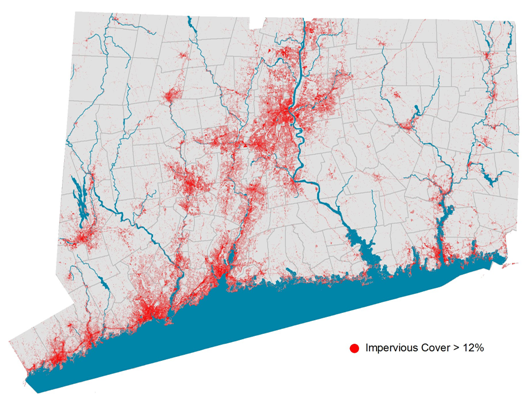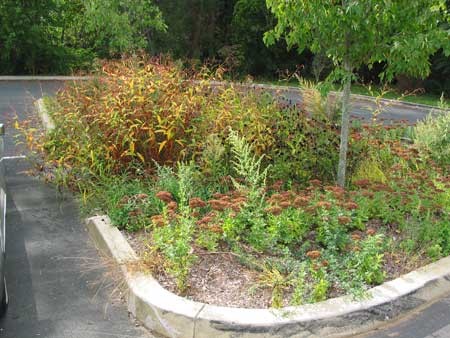Stormwater Planning Tool for Impervious Cover
Stormwater and Impervious Cover (IC)
Stormwater is rain or snowmelt that runs off hard surfaces such as rooftops, road, highways and parking lots. These hard surfaces are collectively called impervious cover. Stormwater that runs off impervious cover can pick up and transport contaminants including motor oils, gasoline, antifreeze, and brake dust (commonly found on pavements), fertilizers and pesticides (found on landscaped areas), and soil sediments (from construction and other sites). The stormwater eventually flows into a local stream, river or lake via a storm drain system.To learn more about storm water and water quality go to the Stormwater and Water Quality web page.
IC and Runoff
The runoff of water can occur anywhere there is impervious cover and stormwater. The figure below depicts the relationship between runoff and impervious cover. As areas are converted from the natural landscape to a developed environment, there is an increase in impervious cover. Areas with greater impervious cover result in greater amounts of stormwater pollution. Runoff picks up contaminants from impervious cover and impervious cover results in more pollutants in runoff. The quality of stormwater runoff is considered poor compared to local waterbodies. Since stormwater discharges to local waterbodies, the amount of impervious cover can impact the surface water quality because of stormwater pollution.
In order to restore and maintain water quality, tools are needed to provide information and guidance to implement management measures within the local watershed.
The figure below, from the Federal Stream Corridor Restoration Handbook (1998), depicts the increase stormwater runoff with the increase in hard surfaces.

What is a Watershed Response Plan? A Watershed Response Plan is a tool used to improve water quality in local waters. This type of plan offers water quality information and guidance for all members of the local community, including the public, municipal officials, businesses and watershed groups. The Watershed Response Plan for Impervious Cover (IC Response Plan) provides details on the local watershed conditions, impervious cover, and implementation measures. The local community can use the IC Response Plan to complement existing stormwater practices and infrastructure management. Improving stormwater quality and reducing runoff can reduce its negative effects and restore water quality in the local waterbodies.
The components of the IC Response Plan include:
Core document: Connecticut Watershed Response Plan for Impervious Cover
Impaired Segment Summaries
Where to target efforts
Included in the IC Response Plan document is a detailed IC analysis of 16 watersheds. These watersheds all have impaired waterbodies and have IC of 12% or more. These watersheds were chosen as examples of waterbodies around the State impacted by stormwater and IC. The Watershed Response Plan is a resource guide to reduce stormwater pollution. It offers guidance on:
- what can be done about IC
- where to target regulating and non-regulating efforts
- case studies of reducing stormwater pollution
- highlights of some impaired watersheds
Fix what's broken

- stormwater retrofits
-
low impact development (LID)
-
best management practices (BMPs) both structural and non-structural


While some techniques may seem novel, there are notable successes of proper installation, adequate maintenance, and stormwater pollution reduction. Examples of these practices include grassed swales, green roofs, tree box filters, rain gardens, and permeable asphalt. Many of these practices have been plotted within towns across the State by CT NEMO (Nonpoint Education for Municipal Officials) in their CT LID Atlas. No single device or practice can be expected to eliminate stormwater pollution, but in tandem, these practices significantly reduce impacts on the quantity and quality of stormwater runoff. Several practices have been studied including research at the University of New Hampshire and show significant improvements in runoff through pollution reduction practices.


Other methods to reduce stormwater pollution are not necessarily structural. Some practices include public education programs such as campaigns to eliminate dumping in catch basins. Also town ordinances can be adopted to encourage techniques to reduce stormwater pollution from new and existing developed areas. Ultimately, the technique or structure regardless of scale has a goal to reduce pollution and impacts from stormwater.
For more information:
View the interactive maps to learn more about stormwater pollution management Plans in Connecticut.
To read about stormwater in a specific town, select the town from the map or choose from the drop-down list.

Visit Total Maximum Daily Loads (TMDLs) to learn more about the tool Water Quality Managers in Connecticut use to address water quality problems.
Receive Water Quality Planning Information by Email
To receive Water Quality Planning Information by email, you must subscribe to the Water Quality Planning email Listserv.
To subscribe to the Listserv:
- Compose an email to listserv@list.ct.gov from the email address you wish to have added.
- You may leave the subject line blank, and in the body of the message type:
Subscribe DEEP_WQPlanning YourFirstName YourLastName
(Substitute your first and last name here.)
Note:If you have an e-mail signature, header, and/or footer set up to be automatically included in emails, you will need to delete these before sending the subscribe request. - After you send the email, you will receive an e-mail confirmation request. Follow the directions to confirm your email address.
- You will then receive an e-mail that you have successfully subscribed to the listserv.
To unsubscribe from the listserv:
-
Compose an e-mail to listserv@list.ct.gov
-
Leave the subject line blank and in the body of the message type:
Signoff DEEP_WQPlanning -
Requests to unsubscribe must be sent from the same email account used when subscribing to the email list.
-
You will then receive an e-mail that you have successfully unsubscribed from the listserv.
If you experience difficulty in subscribing or unsubscribing to the Water Quality Planning Listserv, please email Carol Papp.
Content last updated on February 13, 2020.

